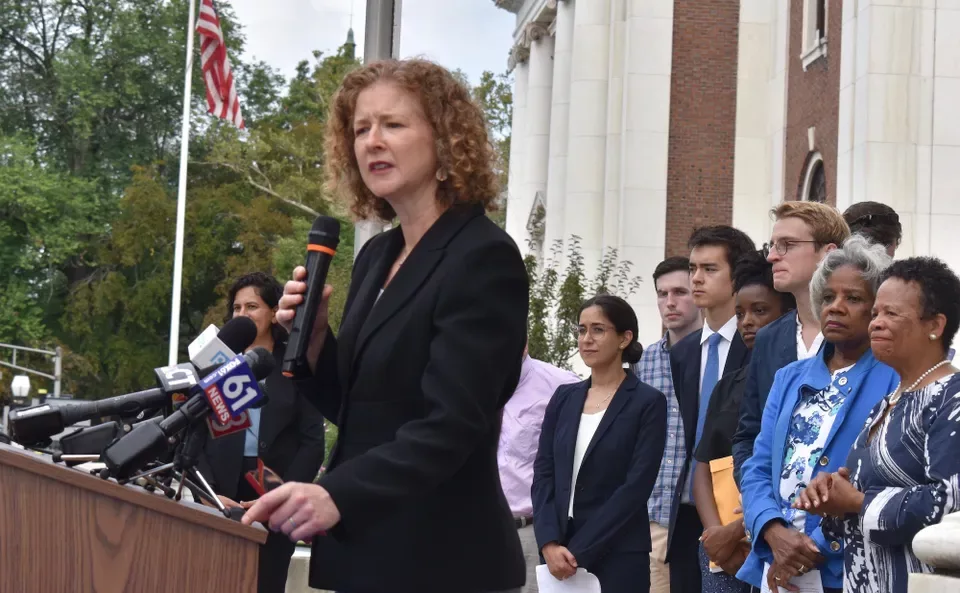Open Communities Alliance Combats the Housing Crisis

The rule of thumb for defining housing as affordable is that a household should not spend more than thirty percent of (30%) its net income on rent or mortgage payments. Yet in Connecticut, more than 200,000 families are estimated to spend more than fifty percent of their take-home pay on housing, according to Open Communities Alliance (OCA) and Partnership for Strong Communities, which track housing data in the state.
To Erin Boggs, the founding director of OCA, the reason for this crisis of housing affordability is explained by Economics 101. The supply is not meeting the demand. “Connecticut is missing a minimum of 135,000 units of affordable housing, and in the New Haven region alone the gap is almost 26,000 units,” Boggs says.
The affordability crisis has only accelerated in recent years amid general inflation, higher construction costs, and rising interest rates for homebuyers. Even rental rates – with average one-bedroom rentals in New Haven costing over $2,000 a month, according to figures from Zillow and RentCafe -- have pushed housing out of reach for many low-income families. Prices are typically higher in resource-rich suburbs, meaning the affordability crisis reinforces existing segregated housing patterns and further limits housing choice.
It’s a reality that Boggs’ organization is working to change through education, advocacy and research, with the support of a recent general operating support grant from The Community Foundation.
The mission of OCA is to increase the equitable availability of affordable housing across all of Connecticut’s 169 towns and cities, and ensure more housing choices for low-income families.
With support from the Community Foundation, OCA conducted community polling across that state to better understand the housing needs. More than 70% of respondents felt that more affordable housing was needed in their communities. That survey data informed the OCA’s policy priorities: building public and legislative support for Fair Share Planning and Zoning; expanding tenant protections; and advocating for the adoption of Fair Share Planning and Zoning, a strategy to equitably meet the state’s housing needs.
The ability of many families to afford a home was exacerbated by the COVID-19 pandemic. While the median wage in Connecticut from 2019 to 2021 declined by 7.2%, the average price of a home rose by nearly 22%, from $263,405 to $320,723, according to a 2021 National Association of Home Builders study.
Boggs says that many myths drive community opposition to affordable housing projects. “People think affordable housing will decrease property values, increase crime, negatively impact schools and perhaps increase property taxes,” she says. “Studies have shown it’s just not true, especially smaller-scale affordable housing [development] in resource-rich communities.”
Government subsidized affordable housing has often been concentrated almost exclusively in poor urban areas, frequently contributing to highly-segregated communities and cementing economic inequalities along racial and ethnic lines. Boggs points to research demonstrating that lower income families living in towns with lower levels of poverty achieve greater economic, health, and educational outcomes. A longitudinal Harvard study found that children who moved to [housing] in lower poverty communities saw their earnings as adults grow by 31%. They were also more likely to go to college and less likely to be single parents. OCA maintains that the reality is that we need more affordable housing everywhere, developed in a balanced way. In addition, in places that are high-poverty, we also need to ensure housing laws are fair to renters and we make deep opportunity-enhancing investments.
To educate communities and policy makers about state and municipal obligations to allow for the creation of affordable housing and ensure fair planning and zoning policies, OCA is partnering with other regional and statewide nonprofits, civil rights organizations, and housing advocates, to promote the Growing Connecticut Together campaign.
What inspires you?
Creating a charitable fund makes a difference now and forever.
While Boggs believes local communities should have choice in housing development in their towns, she adds that they also have an obligation to allow a level of affordable housing.
Traditionally, many communities have created restrictive zoning requirements – like creating large zoning lots for single family homes – that limit the amount of multi-family housing that can be built. Even state rental vouchers – which supplement rental cost so that a low-income family pays no more than 30% of its income for housing – are ineffective in certain communities, according to Boggs. “Unfortunately, the maximum voucher isn’t high enough to [afford living] in lots of communities in the state,” she said.
To address this issue, OCA and its Growing Together partners have advanced Fair Share Planning and Zoning, a new approach to land use that assesses the need for affordable housing in regions across the state, fairly assigns municipalities numerical goals of needed units to guide land use planning and creates a system of incentives to ensure that changes are adopted.
The ultimate answer, Boggs says, is the development of more affordable housing, which is why a fundamental change to the way Connecticut approaches land use is essential. And the tide may be turning. Boggs says the heightened focus on racial equity has created increased support for developing more affordable housing and creating more opportunities for historically marginalized communities to have real choices, both in high-resourced towns and fully-invested cities “There are lots of positive benefits,” Boggs says.
